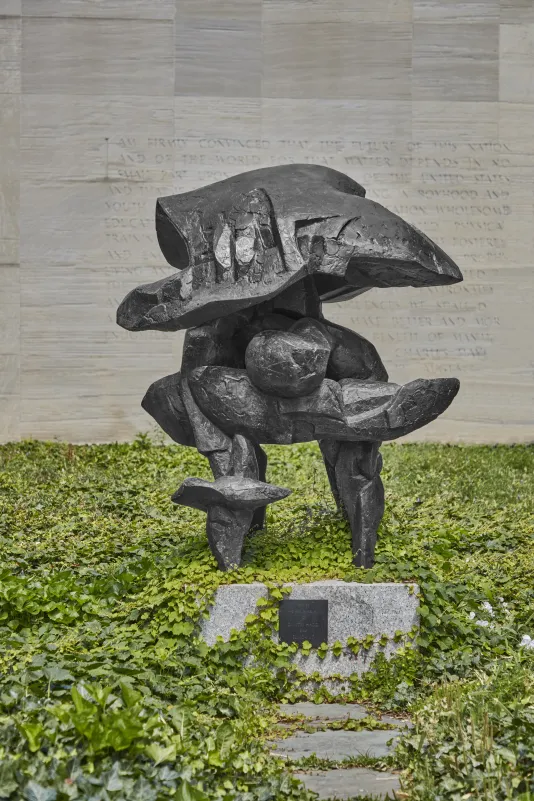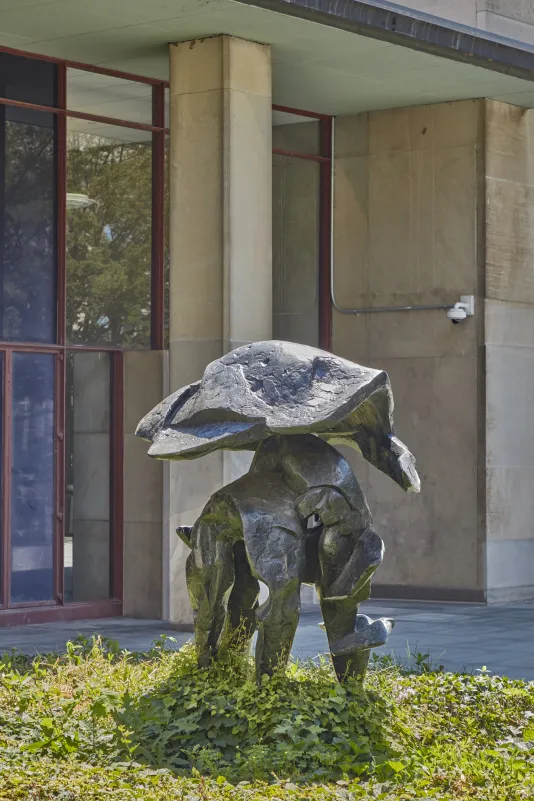Dimitri Hadzi, Elmo-MIT, 1963. Gift of Mr. and Mrs. Samuel A. Marx. Photo: Charles Mayer Photography
Elmo-MIT, 1963

"ALL CAPS FLAVOR" by Lupe Fiasco, GHOTIING MIT: Public Art
Dimitri Hadzi’s Elmo-MIT is positioned in the West Plaza outside the Hayden Memorial Library, which hosts the Institute’s Humanities collections, providing a clear context for Hadzi’s lifelong engagement with motifs from classical antiquity.
By titling this sculpture after the Italian word for helmet, Hadzi linked his bronze to Renaissance images of warriors and to his interest in Greek armor. In a 1981 interview with Robert Brown for the Smithsonian’s Archives of American Art, Hadzi stated that the domineering scale of the sculpture was intended to communicate brutality and strength. But the sculpture’s rounded cap was also meant to recall the domed architecture of Italy, where Hadzi lived for much of his adulthood, as well as the cloud of the atom bomb, which had devastated Hiroshima and Nagasaki less than two decades before. Viewed with these interpretations in mind, the four vertical forms supporting the upper mass may recall architectural columns or exploding buildings more than the limbs of a figure. This range of readings allows the bronze form to simultaneously signify the protection and destruction of its mélange of components.
Elmo-MIT was the first outdoor sculpture at MIT, and its success inspired the next commission, Alexander Calder’s 1965 La Grande Voile (The Big Sail), as well as the continuing practice of placing large-scale sculpture in the campus landscape.
Dimitri Hadzi (1921–2006) was born to Greek parents in New York, where he graduated from Cooper Union and worked at the Brooklyn Museum Art School before moving to Athens and then to Rome in the 1950s. After returning to the United States, Hadzi became a professor at Harvard University, where he taught from 1975 to 1989. In addition to a Fulbright scholarship, Hadzi received a Louis Comfort Tiffany award, a John Simon Guggenheim Fellowship, and an honorary Master of Arts degree from Harvard University. His work was shown in solo exhibitions at the Fogg Art Museum and the Carpenter Center for the Visual Arts at Harvard University; The Phillips Collection in Washington, D.C.; the Hopkins Center for the Arts at Dartmouth College; and numerous commercial galleries. He participated in group exhibitions at the Museum of Modern Art and the Solomon R. Guggenheim Museum in New York; Musée Rodin in Paris; and the Venice Biennale (1956, 1958, and 1962). Hadzi’s work can also be found in many public collections, including the Whitney Museum, New York; the Hirshhorn Museum, Washington, D.C.; and the Museum of Fine Arts, Boston.
